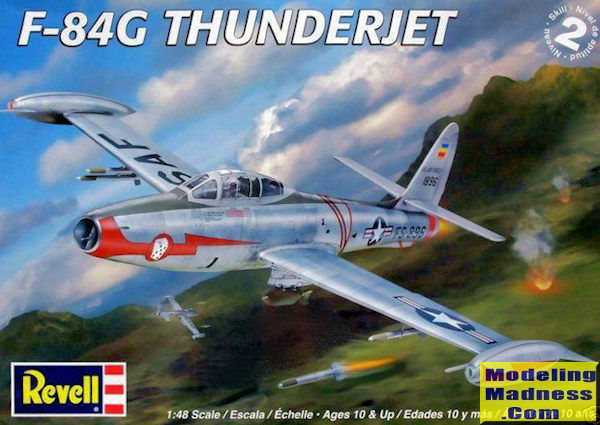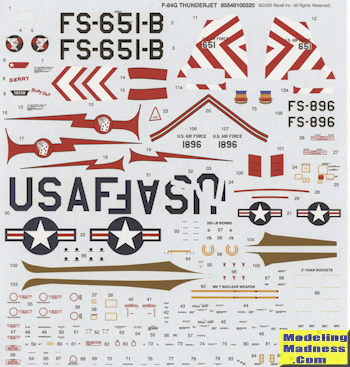
| KIT #: | 85-5481 |
| PRICE: | I paid $5 plus $8 shipping |
| DECALS: | Two options |
| REVIEWER: | Scott Van Aken |
| NOTES: | 2009 Release |

| HISTORY |
The Thunderjet had a distinguished record during the Korean War. Although the F-84B and F-84C could not be deployed because their J35 engines had a service life of only 40 hours, the F-84D and F-84E entered combat with 27th Fighter Escort Group on 7 December 1950. The aircraft were initially tasked with escorting the B-29 Superfortress bombers. The first Thunderjet air-to-air victory was scored on 21 January 1951 at the cost of two F-84s. The F-84 was a generation behind the swept-wing Soviet Mikoyan-Gurevich MiG-15 and outmatched, especially when the MiGs were flown by more-experienced pilots, and the MiG counter-air mission was soon given to the F-86 Sabre. Like its famous predecessor, the P-47, the F-84 switched to the low-level interdiction role at which it excelled.
The F-84 flew a total of 86,408 missions, dropping 55,586 tons (50,427 metric tons) of bombs and 6,129 tons (5,560 metric tons) of napalm. The USAF claimed F-84s were responsible for 60% of all ground targets destroyed in the war. Notable F-84 operations included the 1952 attack on the Sui-ho Dam. During the war, the F-84 became the first USAF fighter to utilize aerial refueling. In aerial combat, F-84 pilots were credited with eight MiG-15 kills against a Soviet-claimed loss of 64 aircraft. The total losses were 335 F-84D, E and G models.
The F-84G was the first single-seat fighter-bomber capable of delivering the Mark 7 nuclear bomb using the LABS, J35-A-29 engine, autopilot, capable of inflight refueling using both the boom (receptacle in left wing leading edge) and drogue (probe fitted to wingtip fuel tanks), introduced the multi-framed canopy which was later retrofitted to earlier straight-winged F-84s. A total of 3,025 were built (1,936 for NATO under MDAP). The larger engine required more air to the face of the engine than the intake could provide at taxiing speeds. Commencing with block 20, auxiliary "suck-in" doors were added laterally to the intake runners ahead of the wing roots. When the engine was deficient of air, the spring-loaded doors were sucked open by the vacuum created by the engine to allow additional air to the engine. When the aircraft reached sufficient airspeed to supply adequate air through the nose intake, the auxiliary doors would close.
| THE KIT |
This particular kit was originally released in the ProModeler boxing back in 1999. It has since been released by Revell AG and also, with some different bits, as an F-84E.
This one is typical of Revell's uber-flimsy boxes. So much so that there is a thick cardboard stiffener installed to help protect the parts. Since Revell USA does not provide a parts diagram, you won't see a layout with this one. Suffice it to say that it is an engraved panel line kit and actually, looks quite nice. Perhaps not Tamiya nice, but still quite presentable.
The cockpit is quite well done with a late bang seat and molded on straps. There are separate side consoles with individual instrument panels. A decal is provided to add over the main instrument panel if you wish. A pilot figure is also included, a staple of Monogram-designed kits, though this one is not seated.
Now, an F-84E and F-84G look the same to the uninitiated, but there are differences. To start, the F-84G has engine blow-in doors to provide additional cooling when on the ground. The E does not have this. Revell has a relatively large insert on each side of the fuselage to account for this difference. The E apparently also has a bit shorter exhaust, so Revell has a one-piece insert for the rear fuselage to deal with this. There are also differences with speed brakes. The G has one with a lot of perforations while the E has four largish rectangles instead. However, I should point out that you will find the E style speed brake on Gs, so if you are really concerned about this, check photos. This kit only has the G style.
Nose gear and intake are divided into left and right sections, leaving a nasty seam that will be impossible to properly fill. There is room at the top of this for weight, though the instructions are moot on how much. ou can also put some inside the intake piece. If all else fails, a clear support rod is provided. Note that the nose gear doors are molded on the intake halves.
Moving to the wings, the tip tanks are molded in place and have refueling probes molded in. These were removable and most photos of Gs show them without them. The G had a refueling door on the leading edge of one wing so there is an insert to deal with this. The builder will need to open holes for the rocket rails. The ones for the inner pylon, which could carry either fuel tanks or bombs, is already open.
The main gear wells are built up of several pieces. The inner
well includes the inner gear doors. Outer doors are separate units that attach
to each other then the main gear strut. Torsion links and retract stru ts
are included. The speed brake well is separate and allows the speed brake to be
posed either raised or lowered. These would often bleed down when on the ground.
Separate flaps are provided and while you can pose them down, pretty much all
the period photos you see of the plane have them raised. The kit does come with
two canopies. One is the braced version that is normally seen and the other is a
smooth one which is not really applicable to the G. While the brace on the real
plane is on the inside, there are external frame lines so you can properly paint
it.
ts
are included. The speed brake well is separate and allows the speed brake to be
posed either raised or lowered. These would often bleed down when on the ground.
Separate flaps are provided and while you can pose them down, pretty much all
the period photos you see of the plane have them raised. The kit does come with
two canopies. One is the braced version that is normally seen and the other is a
smooth one which is not really applicable to the G. While the brace on the real
plane is on the inside, there are external frame lines so you can properly paint
it.
Instructions are well done with generic and FS595 paint colors provided. Two overall unpainted metal planes are provided on the very large decal sheet. One is the box art plane from the 77th FBS in dorea during 1952. The other is from the 9th FBS in Korea during 1953. The big decal sheet is nicely printed and even provides the olive drab anti-glare panel on the top of the fuselage for those who don't want to paint this area. Aftermarket decals are easy to find if you want something else.
| CONCLUSIONS |
The Tamiya kit has a lot going for it and is the choice of many modelers. However, this is a nice one as well and comes with a smaller price tag so is well worth considering. One thing I did not mention is that this kit comes with a Mk.7 nuclear bomb, something not offered by Tamiya. The G was able to use this weapon.
| REFERENCES |
https://en.wikipedia.org/wiki/Republic_F-84_Thunderjet
December 2016
Copyright ModelingMadness.com. All rights reserved.
If you would like your product reviewed fairly and fairly quickly, please contact the editor or see other details in the Note to Contributors.